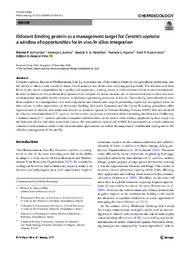Odorant binding protein as a management target for Ceratitis capitata: a window of opportunities for in vivo/in silico integration.
Odorant binding protein as a management target for Ceratitis capitata: a window of opportunities for in vivo/in silico integration.
Author(s): GUIMARÃES, R. P.; SANTOS, V. C.; PARANHOS, B. A. G.; AQUINO, N. C.; NASCIMENTO, R. R.; ALENCAR FILHO, E. B.
Summary: Ceratitis capitata, known as Mediterranean fruit fly, represents one of the main problems to the agricultural production, due the ability to infest a wide variety of fruits, which makes it one of the most worrying pests globally. The infestation of host fruits by the insect compromises their quality and appearance, causing losses to their commercialization and consumption. In order to minimize this problem, fruit growers have adopted the indiscriminate use of conventional insecticides that raise environmental and public health concerns, in addition to promoting resistance in insects. Alternatively, semiochemicals have been explored as a management tool, attracting males and females into traps or promoting repellency in exposed fruits. In this context, in silico approaches, as Molecular Docking, Molecular Dynamics and the Virtual Screening procedures, offer opportunities to identify new molecular entities as potential ligands to Odorant Binding Proteins (OBP), that are involved in olfactory communication of C. capitata. In this review, we present a collection of data including the chemistry of olfactory communication of C. capitata and some computational tools that can be used in these studies, emphasizing their impact on the behavior of this and other associated insects. We also address theoretical ADME-Tox parameters as initial evaluation criteria to ensure human safety in the environmental applications, as well as the importance of molecular synergism for the effective management of the medfly.
Publication year: 2025
Types of publication: Journal article
Unit: Embrapa Semi-arid Region
Observation
Some of Embrapa's publications are published as ePub files. To read them, use or download one of the following free software options to your computer or mobile device. Android: Google Play Books; IOS: iBooks; Windows and Linux: Calibre.
Access other publications
Access the Agricultural Research Database (BDPA) to consult Embrapa's full library collection and records.
Visit Embrapa Bookstore to purchase books and other publications sold by Embrapa.

